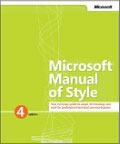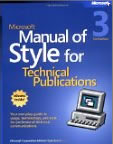Review of the Microsoft Manual of Style (MMOS) 4th Edition
Introduction
 One thing caught my eye right away with the Fourth Edition of the “Microsoft Manual of Style: Your everyday guide to usage, terminology, and style for professional technical communications,” (2012) by Microsoft Press.
One thing caught my eye right away with the Fourth Edition of the “Microsoft Manual of Style: Your everyday guide to usage, terminology, and style for professional technical communications,” (2012) by Microsoft Press.
What was it? It was the title—slightly changed from that of the Third Edition. The Third Edition proclaims that it is the “Microsoft Manual of Style for Technical Publications: Your everyday guide to usage, terminology, and style for professional technical communications.” [The emphasis is mine.]
The back cover of the Third Edition reads, in part, “The essential reference for technical writers, editors, journalists, and everyone else who writes about computer technology.” That line made me buy the book. The phrase “ideal reference for technical writers” screamed at me to buy it. And I did. I still have it and refer to it almost every day.
Surprisingly, in the Fourth Edition, the phrase “Technical Publications” has been removed from the main title of the book. And now the back cover of the Fourth Edition reads, in part, “The ideal reference for Writers, Editors, Content Creators, and Content Managers.” The new book no longer seems to be quite as concerned about technical writing. Content curation seems to have bubbled to the surface and usurped technical writing.
Let’s investigate the new MMOS and see what has changed between Third and Fourth editions. Is the MMOS really less about technical writing now?
Highlights for Technical Writers and Other Content Creators
The MMOS4 comes in two parts. Part 1 contains 11 chapters packed with information. Part 2 is fully occupied with the nitty-gritty Usage Dictionary.
 My well-used Third Edition has been tagged with tons of sticky notes since I got it. I immediately opened the Fourth Edition to see how its Usage Dictionary stacks up to its predecessor. One item of usage that always kills me is the word “press.” Should I press, type, hit, pound, or perform a soft-shoe tap-dance on a key?
My well-used Third Edition has been tagged with tons of sticky notes since I got it. I immediately opened the Fourth Edition to see how its Usage Dictionary stacks up to its predecessor. One item of usage that always kills me is the word “press.” Should I press, type, hit, pound, or perform a soft-shoe tap-dance on a key?
This is where it gets interesting. The Third Edition was black and white in its statements. Your usage was either “Correct” or “Incorrect.” When I was starting in tech writing, the strict proclamations of right and wrong were comforting.
The Fourth Edition has a lighter and friendlier style, which I must admit, I like more. Usage choices are now categorized as “Microsoft Style” and “Not Microsoft Style.” The introduction to the Fourth Edition mentions this, saying, “We don’t presume to say the Microsoft way is the only correct way.” Goodbye, 2004. Hello, 2012!
One chapter I looked for in particular is titled, “Documenting the User Interface.” In the Third Edition this is Chapter 1 and it was immensely useful to me several years ago. I highlighted passages and stuck sticky notes all over it. Is this info still there and is it still helpful? Heck, yes. But this information now resides in Chapter 5 in “The user interface.” The first chapter in the Fourth Edition concerns itself with “Microsoft Style and Voice.” This is not to say that the UI details got demoted. Far from it.
The older chapter has 25 pages. The Fourth Edition’s chapter on user interfaces was expanded to 47 and recognizes that more than one interface exists. There are a lot of them, especially with the virtual tsunami of mobile devices, including the Windows Phone, which, in case you didn’t notice, also has a user interface.
I’m in constant need of refreshers on how to use first person, second person, and third person. The Third Edition says, using third person is “Correct, but Remote.” I thought this was delightful phrasing. I mean, I love being correct, but who wants to be remote? MMOS3 continues, saying second person (direct address) should predominate, while first person should be avoided.
No such cautionary finger-wagging in MMOS4. In the Fourth Edition, third person isn’t even mentioned, as far as I could tell. Instead, MMOS4 suggests we use second person in general, and first person sparingly.
Conclusion
Is the Fourth Edition worth buying? Yes. I miss the old declarations of right and wrong, the lack of which could steer a novice technical writer off course. But, the MMOS4 is not as strident, recognizing that while Microsoft remains a dominant style, it is now one of many to choose from.
The MMOS4 only appears less technical. The bespectacled computer geek wearing a short-sleeved white shirt and brandishing a pocket protector as a badge of honor *looks* decidedly technical. The web developer wearing ripped jeans and faded T-shirt is also technical, but simply doesn’t emphasize it as much.
Neither does the MMOS4. The Fourth Edition doesn’t dwell on its technical nature. The new MMOS4 has grown up, is comfortable in its own skin, and is cool with being technical.
- Paperback: 466 pages
- Publisher: Microsoft Press; Fourth Edition edition (January 27, 2012)
- Language: English
- ISBN-10: 0735648719
- ISBN-13: 978-0735648715